It was one of those glorious New York City days – everything was bright and crisp, sparkling in October sunlight. It was 2016 and I was on a walking tour of the East Village to commemorate the fourth anniversary of Hurricane Sandy. We visited community gardens, a ConEd generating station, East River Park and other affected sites, noticing the (almost) invisible scars left by the storm.
Then I joined Bob Bland and a group of activists in Union Square. We wore matching jumpsuits and held hands, forming a human “wall” against misogyny. We stood in silence. The US presidential election was imminent. The climate emergency was everywhere. We closed our eyes. I saw orange mushroom clouds and the end of human civilisation, as we know it.
Since then – for four years – I have marched through the streets, carrying signs, sharing messages of solidarity, embracing a collective grief and anger. Words of hope and action pinned to my bag. I have stood on the steps of the New York Public Library (and in Times Square, Central Park, Washington Square Park, Foley Square, Union Square, at City Hall, on the Brooklyn Bridge, and in the middle of Fifth Avenue) countless times with members of PEN America, Extinction Rebellion, Rise and Resist, and other groups declaring WORDS MATTER.
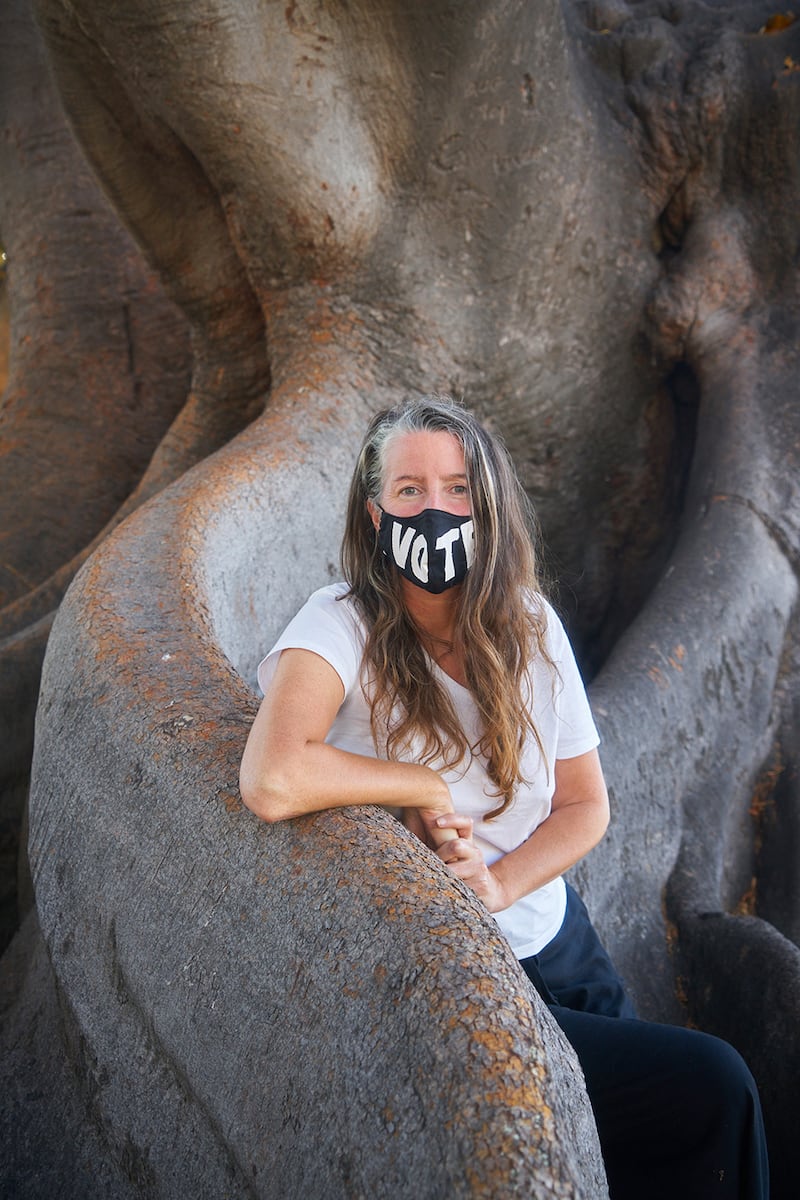
It has been affirmed repeatedly, often eloquently, always emotionally. You might have seen us. You might have been there with us. You might recognise me. We might recognise each other.
Perhaps you have also felt the weight of words while marching in solidarity. Words Matter. Truth Matters. Science Matters. Facts Matter. Black Lives Matter. Democracy Matters. It all matters. We are all matter. But what is matter, we may ask? The word itself is suggestive of what’s at stake. The etymological roots expose a tension. The Latin materia suggests “timber” while mãter means “mother” or “source”. So, matter is a hybrid, a woody, fleshy fusion of living tissue with a semiotic heart. The heartwood, if you will.
What about words? Words are the smallest units of language that stand alone. They are central to our experience of being human. The languages we speak profoundly shape the way we think, the way we see the world and the way we live. If language – like everything else – is a direct extension of nature, then it was here before humans.
But without language fossils we can’t be certain of the origin of human language or words. Prehistoric handprints (and newly discovered fingerprints) matter to us, as they are the first human-made inscriptions in our known universe. They were made by people spitting pigment (itself a fine form of matter) at their outstretched hands, creating signatures, reaching across time.
The most influential artifacts of our civilisation are word mountains, what we call stories or books. Our ancestors shared messages through stories and some of those have reached us as collective stories – books – like the Bible and other creation myths. Stories evolve as multiple authors repeat, copy, translate and circulate them. In America there is the Constitution. In Ireland, the Book of Kells and Book of Ballymote.
What exactly is a book? With roots in Old English boc referred to Proto-Germanic, from bokiz “beech”, itself the source of the German Buch “book” and Buche “beech”. Latin and Sanskrit also have words for “writing” that are based on tree names (Birch and Ash, respectively). The French livre “book” comes from Latin librum, originally “the inner bark of trees”. Again, we’re spiraling in towards the Heartwood.

Ireland’s medieval Ogham, sometimes called a “tree alphabet”, used trees for letters. The characters were called feda “trees”, or nin “forking branches” due to their shape. Astonishingly, this ancient alphabet was “written” from the ground up – each character sprouting from a central line, like leaves on a stem or branches on a tree. Language as living matter.
It can’t be a coincidence that some of the first forms of writing used trees. Our natural capacity to produce language is innate, like a tree’s ability to produce leaves. Buds burst with potential stories. Words are human constructs, concepts representing ideas and categories of things. Words create meaning, they are alive and shift with culture. Words can be planted. They matter. We can seed stories, watch them take root and grow. That’s what makes us human.
But language is not unique to humans. The world is a text waiting to be deciphered. There are stories everywhere. We can unearth words, pluck them from the air. Back on that October day in 2016, during our Sandy walk we “read” the landscape; deciphering marks written on the architecture of the city by events that took place that storm ravaged night.
Watermarks on the side of buildings are obvious. But perhaps less obvious are other lines that can be read: A beautiful weeping willow was dripping over the fence from a community garden creating much needed shade for our group. If you know how to read the invisible city, as we were, this tree indicated a high water-table, revealing a natural water source. Inevitably, the area flooded badly that night. Everything is alive, writing history. You just have to know how to read it.
So, the world is a story writing itself. Things themselves are verbs, not nouns. Indigenous people know this. Robin Wall Kimmerer calls it the Grammar of Animacy. The Earth herself moves, living through deep time that we humans find difficult to grasp. When I’m home, walking in the west of Ireland, I know that every stone has a story, every line in the landscape records a life lived (Tim Robinson’s exquisite work attempts to map it). Stories already exist, written in stone and tree, wind and water, we’ve just forgotten to look, forgotten how to read them. During lockdown some of us have had time to slow down and look closely at our local landscapes.
Growing up in rural Ireland I found solace in trees. Trees are truthful. When I moved to New York City, inevitably, I was drawn to street trees. The City commissioned me to create a Tree Museum to celebrate the centennial of the Grand Concourse in 2009. I was lucky to meet thousands of wonderful residents of the Bronx, both human and arboreal, and share their entangled stories.
This led me to search for a tree language or a “forest of tree languages”. Scientists like Suzanne Simard, Peter Wohlleben, Hope Jahren and Merlin Sheldrake study the language of plants. They’ve shown how trees talk to each other using mycorrhizal fungi, an underground hyphal network, affectionately called the wood wide web. These “natural” languages exist beyond our notion of communication.
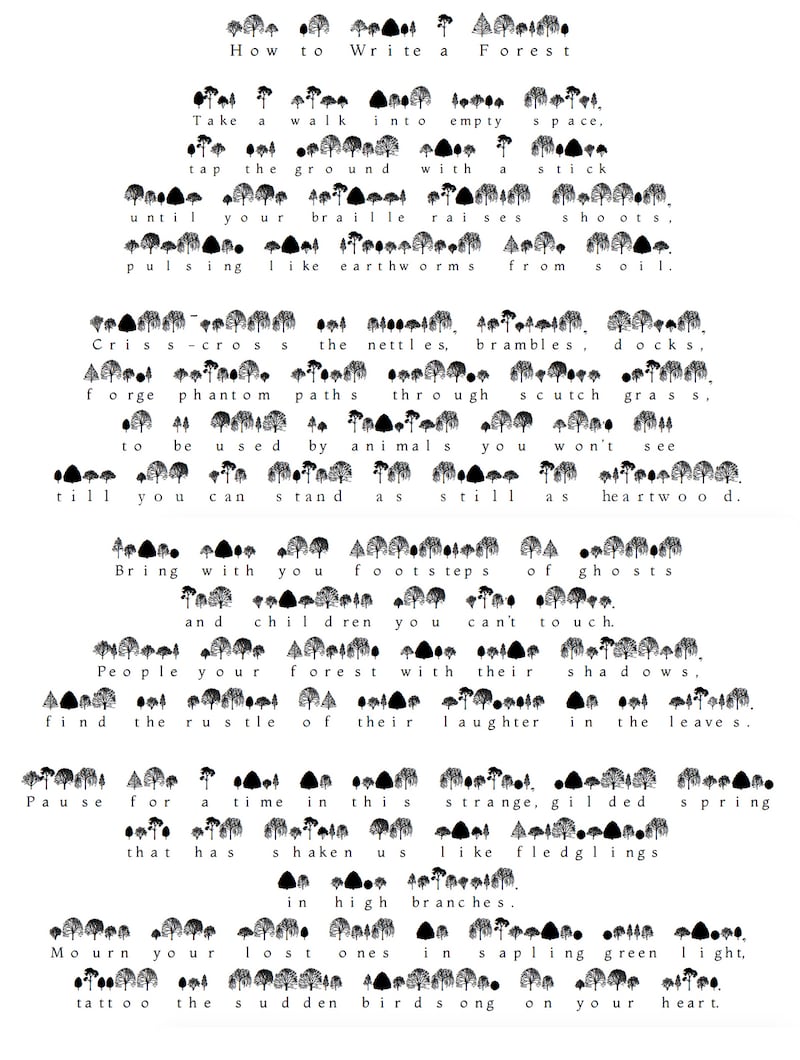
Learning about the language of trees, their social networks and our own human microbiome, forces us to rethink our relationship with “things”. If trees have memories, respond to stress, and communicate then what can they tell us? Will we listen? Where does one species begin and end? What are the ethics of vegetal life? What happens when we know plants can talk? Should we eat them?
Our understanding of Homo sapiens’ place in the world is undergoing tectonic shifts. We have affected the Earth’s intertwined biological systems to such an extent that the lines between things that are born – trees, bacteria, cats – and things that are made – cities, computers, codes – have begun to blur. Robotic Dolphin, anyone?
We are confronted with crises on a global scale affecting interconnected systems such as water, food, energy, and ecosystems. Hello, Coronavirus! We have created a new geological epoch, the Anthropocene, also known as Plasticene, Capitalocene, Plantationocene or Chthulucene. Donna Haraway wonders whether perhaps “The Dithering” is a more apt name. Whatever it’s called, we are writing ourselves into the Earth’s veins. We are compost.
We compose. Writing is how we compose ourselves and make sense of the world. Reading is also a form of composition. Translation is perhaps the closest form of reading. Could translation be the most intimate way to compose and conjoin ourselves with the world around us?
Sensing a crisis of representation as our species sleepwalks into the Anthropocene, I became fascinated with the possibility of drawing a language beyond my native human tongue. So I drew a family of trees, one for each letter of the Latin alphabet, creating a Tree Alphabet and a typeface called Trees. Why write with Times when you can write with Trees?
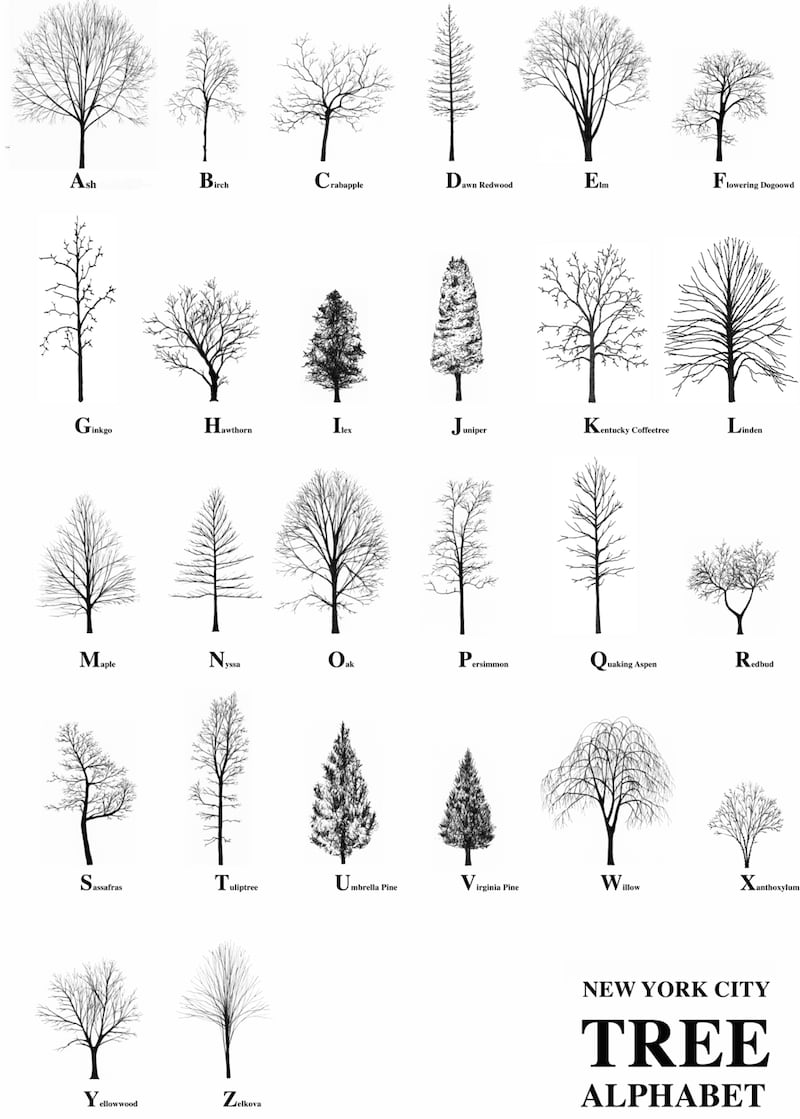
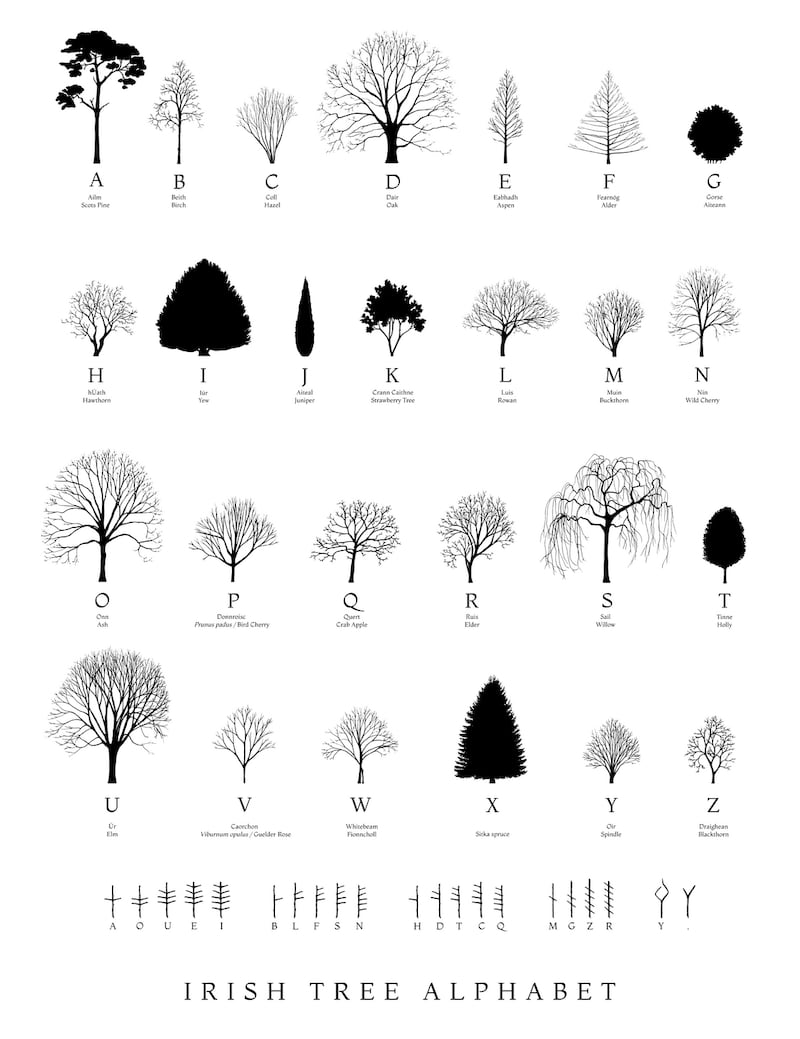
The new alphabet offered a way to elucidate the paradoxes of the Anthropocene by slowing us down to decipher words in the woods. When we translate our words into glyphs, like trees for example, it forces us to re-read everything. The tree ABC helps us re-read the past, re-present the present, and re-imagine the future by offering a simple way to translate what we think we already know. I translated beloved texts into Trees and published the book About Trees.
Fonts are ubiquitous, replacing handwriting. Every time we sit at our devices we tap out messages, letter by letter. The new Trees font allows us to play with the molecules of language. New letter forms – Trees – replace each letter in the Latin ABC. As we tap, trees sprout on screen. Words may be the smallest units of language, but letters are the tiniest “bits” of our language ecosystem. By transforming a Latin character into a digital Tree, can we acknowledge and expand our understanding of knowledge, typography, books and stories themselves?
The Tree Alphabet also makes it possible to plant messages with trees – letter by letter, tree by tree – reforesting our imaginations, reimagining our public spaces and reconsidering monuments. We can also ingest the alphabet, seeding stories within plant DNA by encoding messages at the molecular level. We become the stories we tell ourselves and our children. What stories do we want to leave behind? Let’s write ourselves into the future. Let’s plant stories.
I wanted to create a living alphabet – something we could plant – to literally make words matter. Bram Gunther, Director of the Urban Field Station, the science and research hub of Forestry, Horticulture, and Natural Resources of the New York City Parks Department, loved the idea and in 2018 I was invited to be an Artist-in-Residence. I made the New York City Tree Alphabet and a typeface called New York City Trees.
I made a TREE ABC for NYC. Each letter of the Latin alphabet was replaced by a tree from the Parks Department’s existing native and non-native trees, as well as species that are to be planted as a result of the changing climate. My tree drawings were transformed into a free font, so anyone anywhere can write with New York City Trees. We plan to plant secret messages around the city with real trees.
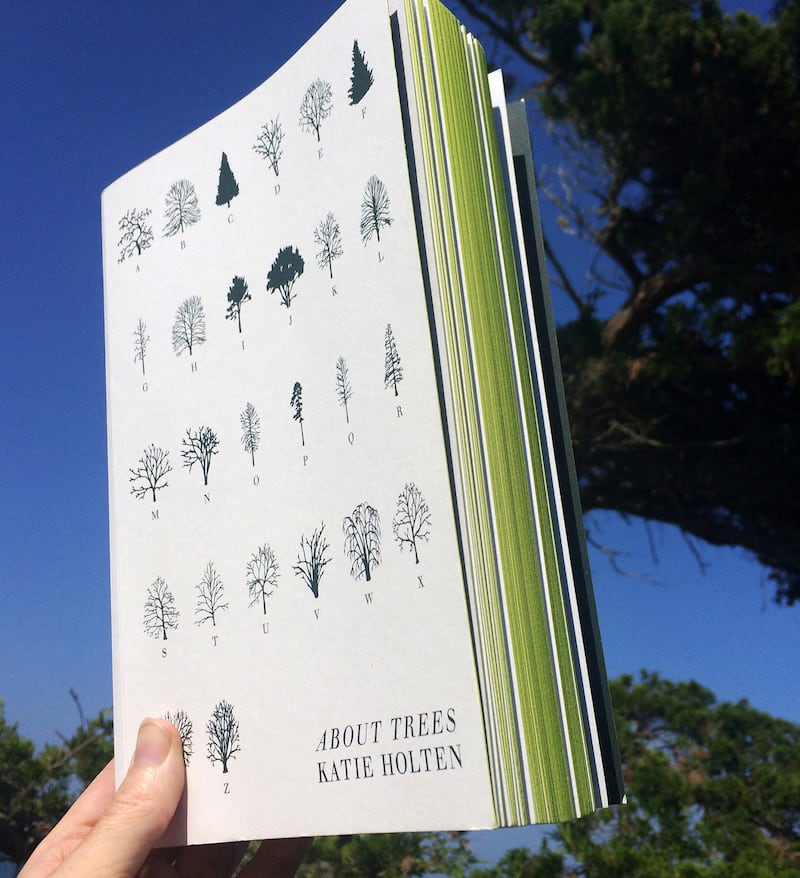
The Tree Alphabets reverse a conventional process by which human, symbolic language runs from thing to idea via word by translating letters into cryptic glyphs. Texts are translated into a forest of encoded meaning, language turned back upon itself, as it were, by (re)turning letters to a pictographic field, exploring the fantasy of seeding a linguistic empty field, or blank page. (I remember the poet Paula Meehan described the work of writing to me, like a farmer ploughing a field, she said, digging lines in the land, writing a future harvest, seeding notions, planting memories…)
Language is composed of words, which are constituted from letters, which are shared as fonts, typefaces, handwriting and primitive marks. But what exactly are the smallest units of matter themselves composed of? Lucretius called them semina rerum, “the seeds of things”. He wrote (in Rolfe Humphries’s translation) that they,
Are necessary to support our lives.
By the same token, it is obvious
That all around us noxious particles
Are flying, motes of sickness and of death.
In 1948 Richard Feynman shared his beautiful diagrams to illustrate how the hypothetical tiny particles inside atoms – fundamental constituents of matter – behave and interact. More recently, Angelo Bassi has said of the new Objective-Collapse theory that we need to imagine “particles” replaced by a “hybrid jelly blob” that can spread out in space, split and recombine. Yes, it can move in many directions at once, navigating multiple paths simultaneously, potentially following Borges’ Forking Paths. This could explain why Schrödinger’s cat is both dead and alive at the same time. What could we see with those cat eyes?
What if we could see with our own microbiome? Like lichen, we are composed of multitudes. Recently our sense of self was shattered when we learnt that more than half of the human body is not human. Like most of the Tree of Life, our very own body is a mystery.
Right now our collective sense of self is being crushed as our species is attacked by an invisible virus. Yet, bacteria and other organisms take root in our gut, they branch, bud and burst. We are community all the way down. Just as forest trees are part of a collective wood-wide-web, the “I” of an individual is a collective. (Coincidentally, “I” in the Irish Tree Alphabet is Iúr or Yew, rhymes with You. Get it? I is You.) How can we see collectively?
Roy Scranton eloquently asserts that “Our drive to make meaning is more powerful than oil, the atom, and the market, and it’s up to us to harness that power to secure the future of the human species. … We need to learn to see not just with Western eyes but with Islamic eyes and Inuit eyes, not just with human eyes but with golden-cheeked warbler eyes, coho salmon eyes, and polar bear eyes, and not even just with eyes at all but with the wild, barely articulate being of clouds and seas and rocks and trees and stars.”
Perhaps writing with Trees can help us “see” beyond our human eyes. Translating text into Trees can help us learn to see beyond ourselves.
“In the end, we will conserve only what we love; we will love only what we understand and we will understand only what we are taught.”
Baba Dioum, a Senagalese forestry engineer, shared these words in a speech to the general assembly of the International Union for Conservation of Nature in New Delhi in 1968. It’s a simple message. You can only love what you know. You can only know what is named. What isn’t named can’t be considered. And what can’t be considered can’t be acted upon. If the words “Climate Emergency” are not mentioned – (or “Climate Change” is deleted from official documents) – then we can’t consider that reality.
Because words do matter – more than we can imagine – I’m terrified of what has happened since we stood together in Union Square. Language has become pretzel-like, words twisted, truth squashed like playdough. What are we (as a species) if words lose their meaning?
We need to respect the words we already have, remember the words we’ve forgotten, and create new words for our emerging sense of a collective self. We need new stories, sharing secrets from a possible future, to help us see beyond ourselves and the past we’ve written. We need other perspectives, from Beech, to Birch, to Book, and back again.
Because words do matter, I offer the Irish Tree Alphabet – a new ABC – as a way to reforest our imaginations, suggesting a way forward by looking backward through our branches of knowledge. Trees, by growing outwards from their heartwood, share their secret with us; time is not linear but spirals out. This new alphabet was made while I’m quarantined here in California, but is rooted in Ireland’s medieval Ogham. Letters germinate, like seeds. Trees sprout on the blank page/screen. Punctuation marks explode like seeds and nuts, leaves unfurl.
If 2020 has shown me anything, it’s that we need to expand our dreams and imagine an extraordinary future. If we continue on our current trajectory our species will sleepwalk into extinction. We need to reach through space and time, forwards and backwards, to care for each other as a human community. Holding hands, alone together, we need to close our eyes and see another way of being.
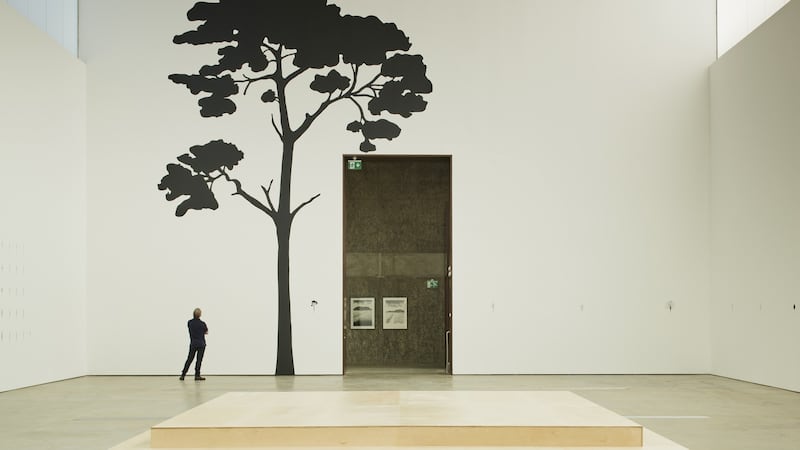
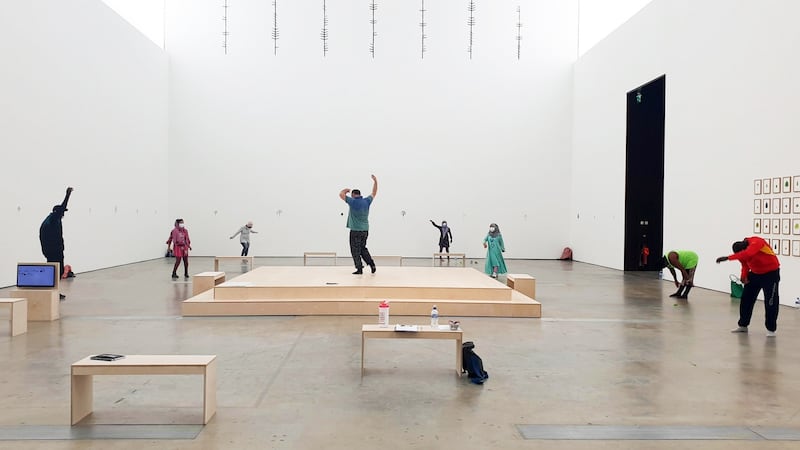
We need to think like the multicellular organism that we are and imagine fundamental, systemic changes. Then we need to rewrite everything. That's where Trees come in. Trees can help us translate our old words and stories, what we thought we knew. I invite you to download the free fonts. Translate your words – your tweets and thoughts, your twigs of reason – into Trees. The act itself of composing love letters to our future selves might just be what makes our future selves possible.
Irish Tree Alphabet by Katie Holten runs at Visual Carlow until October 18th










